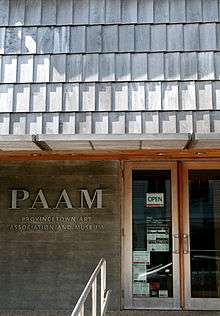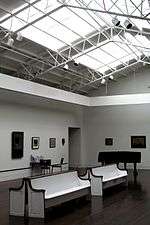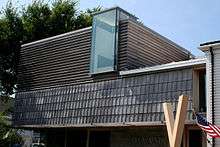Provincetown Art Association and Museum
The Provincetown Art Association and Museum (PAAM) is located at 460 Commercial Street in Provincetown, Massachusetts. It is accredited by the American Alliance of Museums and is the most attended art museum on Cape Cod. The museum's permanent collection includes over 2,500 objects, a number which continues to grow through donations and new acquisitions. PAAM mounts approximately forty exhibitions each year.[1]
 PAAM entrance | |

| |
| Location | Provincetown, Massachusetts |
|---|---|
| Coordinates | 42.0564°N 70.1794°W |
| Type | Art Museum |
| Website | paam.org |
History
Origins

Prominent artists Charles Hawthorne, Oscar Gieberich, William Halsall, Gerrit Beneker, E. Ambrose Webster and several local business men and women established the Provincetown Art Association in 1914. The organizing artists donated works and mounted two juried exhibitions in the summer of 1915, beginning a tradition of collecting and exhibiting the work of local artists. By this time, Provincetown had become a refuge of artists and expatriates returned from war-torn Europe. The town was firmly established as "The Biggest Art Colony in the World" (Boston Globe, 8/8/16). PAAM strengthened its role as the anchor of this art colony through the purchase of its present building in 1919. John "Wichita Bill" Noble served as the Association's first director. His son, John A. Noble, also became a prominent artist.
Twentieth Century
PAAM's artist founders had come out of the Impressionist tradition and thus did not readily accept the new Modernist movement. Faced with aesthetic differences among its artist membership, however, the organization worked to maintain a balance in the work it exhibited. True to its mission, PAAM mounted separate "Modern" and "Regular" summer exhibitions between 1927 and 1937. Partial conciliation was reached in 1937 when concurrent exhibitions were hung in the same gallery on opposite walls.
The Depression years of the '30s and the war years of the early '40s were difficult times for the town and the Association. Although annual shows were canceled, volunteers managed to maintain a reduced schedule. By 1947, the regular schedule of two summer exhibitions had been reestablished. The rise of Abstract Expressionism—intensified by the location of Hans Hofmann's summer school here—again riffled the deep divisions within the arts community during the '50s.
When PAAM celebrated its 50th anniversary in 1964 with a retrospective show of its major artists, the organization focused on gaining national attention for Provincetown's considerable contribution to American art. The effect was a boon for the organization. Activities increased, new galleries were added, the exhibition schedule expanded, a storage vault was built to house the expanding collection, and once again PAAM showed itself as the center of the local art world.
As PAAM grew throughout the next three decades, the organizational structure of the museum continued to include strong representation from both the artist and lay communities. PAAM'S dual purpose of the organization—to be a collecting museum and a professional artists' association—has been consistently supported over the course of its history. The collection has been the basis for many exhibitions and has served scholars, researchers and other museums. Including close to 2,500 works from artists who have lived or worked on the outer Cape.
Recent
PAAM continues to acquire both historical and contemporary works. The galleries also offer accommodating venues for chamber music, jazz, dance and spoken word performances. The new studio classrooms offer spaces for children and youth education programs, as well as for adult courses in the Lillian Orlowsky/William Freed Museum School at PAAM.[2]
Timeline
Select art historical events in Provincetown over the past 100 years
| Date | Event |
|---|---|
| 1899 | Charles Hawthorne establishes the Cape Cod School of Art |
| 1900 | E. Ambrose Webster establishes the Summer School of Painting |
| 1914 | Provincetown Art Association established on August 22 |
| Influx of artists and writers from New York and Paris | |
| 1915 | The Provincetown Art Association has its first exhibition at Town Hall |
| The Provincetown Print Makers formed, inspired by B.J.O. Nordfeldt | |
| 1916 | George Elmer Browne forms the West End School |
| The Modern School of Art is formed by B.J.O. Nordfeldt, William and Marguerite Zorach, Frederick Burt, and M. Musselman Car | |
| The Beachcombers, a men's club of artists and writers, established | |
| 1921 | 7th Annual Exhibition opens at the Provincetown Art Association – first exhibition at its current location, 460 Commercial. Association constitution and bylaws created |
| 1927 | The First Modernist Exhibition opens as a result of a petition drawn up by Ross Moffett, Tod Lindenmuth, and thirty other artists in 1926 |
| 1933 | Hans Hofmann School of Fine Art established – located on Miller Hill in the rented studio formerly occupied by Charles Hawthorne's Cape Cod School of Art |
| 1937 | The first combined exhibition of modernists and traditionalists is held at the Provincetown Art Association |
| 1946 | Hans and Miz Hofmann purchase the Waugh studio on Commercial Street at Nickerson Street; Hofmann continues teaching |
| 1949 | Forum 49 exhibition opens at Gallery 200 |
| 1950s | Abstract Expressionism flourishes |
| 1959 | Galleries and Artists’ Cooperatives reach a peak on Commercial Street |
| 1968 | The Fine Arts Work Center is established |
| 1970 | The Provincetown Art Association changes its name to the Provincetown Art Association and Museum, recognizing its mission as a repository of artworks, objects, and archives relevant to the history of art in Provincetown |
| 1978 | The Lower Cape Arts and Humanities is formed |
| 1979 | The First Annual Fall Arts Festival is launched |
| 1982 | The Museum School at the Provincetown Art Association and Museum is established |
| 1985 | Provincetown Arts Magazine is established |
| 1999 | Provincetown celebrates its 100th anniversary as an Art Colony |
| 2006 | Renovation and expansion of the Provincetown Art Association and Museum completed by the architectural firm of Machado and Silvetti Associates |
Facilities


The Provincetown Art Association and Museum has five ground-floor galleries with rotating exhibitions on view throughout the year. Three sculpture gardens surround the building. The Museum School facilities include second-floor drawing, painting, and print studios. The entire building is equipped with an all-season climate control system.
A recent renovation and expansion of the Provincetown Art Association and Museum has dramatically improved the museum's ability to store and display art. In 2006, the square footage of the facilities was increased from 11,000 to 19,500 square feet (1,810 m2).
PAAM's physical plant has been awarded a Silver LEED rating by the United States Green Building Council to recognize PAAM's Leadership in Energy and Environmental Design. The rating quantifies PAAM's environmental performance, and assures the public that PAAM's facility is designed and operated to help save energy and natural resources.[4]
The renovation project, designed by Machado and Silvetti Associates, has also received a 2006 American Institute of Architects Merit Award for Design Excellence, and recognition within the AIA's 2007 Committee on the Environment (COTE). The building is wood-frame construction over a concrete basement. The historical portion of the Museum, which is listed on the National Register of Historic Places, is clad with white cedar shingles; the new portion of the Museum is clad with custom Spanish cedar shingles and louvers.[5]
Collection
PAAM's permanent collection features artists who have lived and worked on the Outer Cape. Some artists represented in the collection include Varujan Boghosian, Paul Bowen, George Elmer Browne, Oliver Chaffee, Carmen Cicero, Ciro Cozzi, Charles Henry Demuth, Edwin Dickinson, Chaim Gross, Charles Webster Hawthorne, Robert Henry, Henry Hensche, Hans Hofmann, Erik Koch, Franz Kline, Karl Knaths, Blanche Lazzell, William Littlefield, Peter Macara, Ross Moffett, Robert Motherwell, Man Ray, John Singer Sargent, Jack Tworkov, Andy Warhol, E. Ambrose Webster, Mike Wright, and James R. Zimmerman. For a complete inventory list of the collection, please visit the PAAM collection webpage.
Educational Programming
The Lillian Orlowsky/William Freed Museum School offers a range of classes and programs throughout the year. Over seventy summer studio courses are offered from May through September, including courses in drawing, printmaking, mixed media, plein air painting classes with prominent local artists, and computer classes. Life drawing sessions are offered twice a week year-round, and the Museum School holds open print studio hours during the winter. Fall, winter, and spring courses include week-long master classes, multi-week workshops, and semester-long offerings. This exciting program exemplifies PAAM's commitment to year-round educational opportunities for absolute beginners, established artists, and everyone in between.
In addition to adult courses, the Museum School also coordinates classes for children and teens. Art Reach, a 28-week after-school program created in conjunction with Provincetown High School, runs from October through May. PAAM also facilitates student curating sessions and offers children's art workshops in the summer.
Studio workshops are supplemented by free educational lectures. The Fredi Schiff Levin Lecture Series runs from June through September, with additional lectures taking place periodically as well. Guest lecturers include artists, authors, and art historians who are brought in to discuss the history of the Provincetown Art Colony as well as its contemporary art scene.[6]
Gallery
 Visitors outside of the front museum entrance
Visitors outside of the front museum entrance- A life drawing course in session
See also
- Provincetown Printers, an art colony of the early 20th century
References
- PAAM Style Guide for Consistent Organizational Positioning.
- "Archived copy". Archived from the original on 2009-02-10. Retrieved 2009-08-11.CS1 maint: archived copy as title (link)
- Building on a Legacy: The Tides of Change. Provincetown: Provincetown Art Association and Museum, 2003.
- "Archived copy". Archived from the original on 2009-07-05. Retrieved 2009-08-11.CS1 maint: archived copy as title (link)
- "Archived copy". Archived from the original on 2009-02-05. Retrieved 2009-08-11.CS1 maint: archived copy as title (link)
- Provincetown Art Association and Museum Fall Newsletter. 2009.
External links
Further reading
- Ahrens, Nyla. Provincetown: The Art Colony, A Brief History and Guide. Provincetown: Provincetown Art Association and Museum, 2000.
- Bridges, Robert and Kristina Olson. Blanche Lazzell: The Hofmann Drawings. Morgantown: West Virginia University Press, 2004.
- Moffett, Ross. Art In Narrow Streets: The First Thirty-Three Years of the Provincetown Art Association 1914-1947. Provincetown: Cape Cod Pilgrim Memorial Association, 1989.